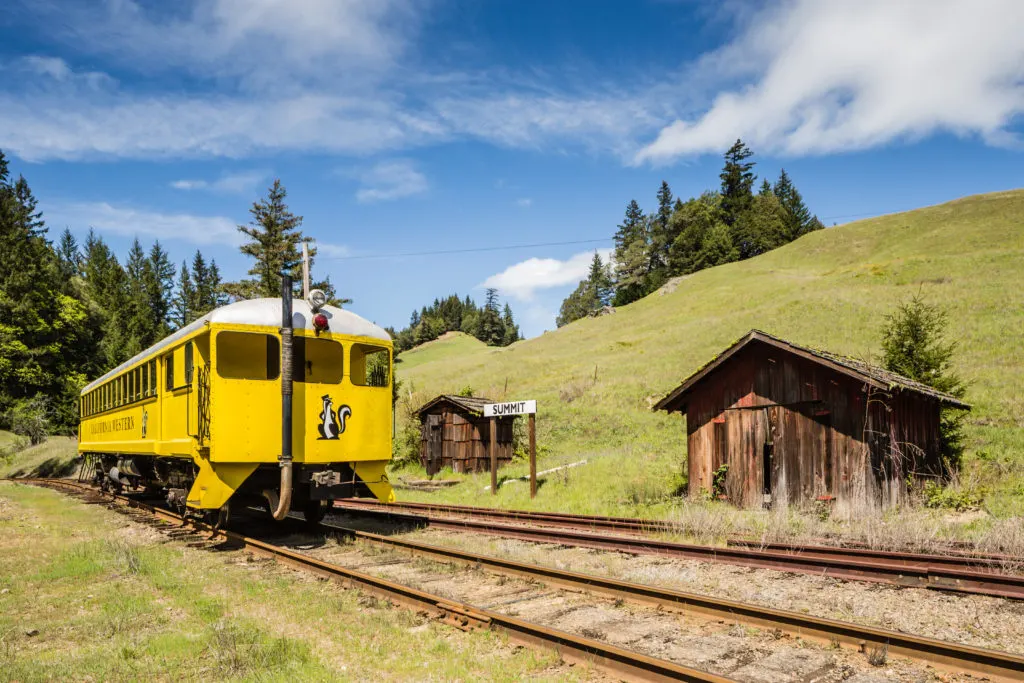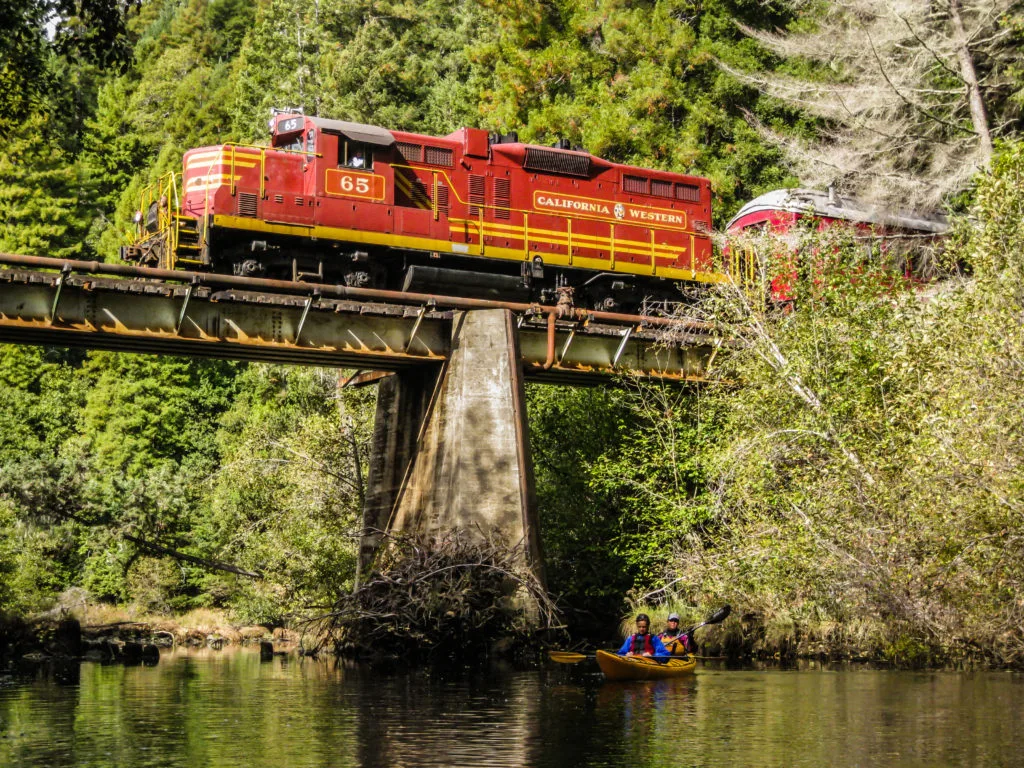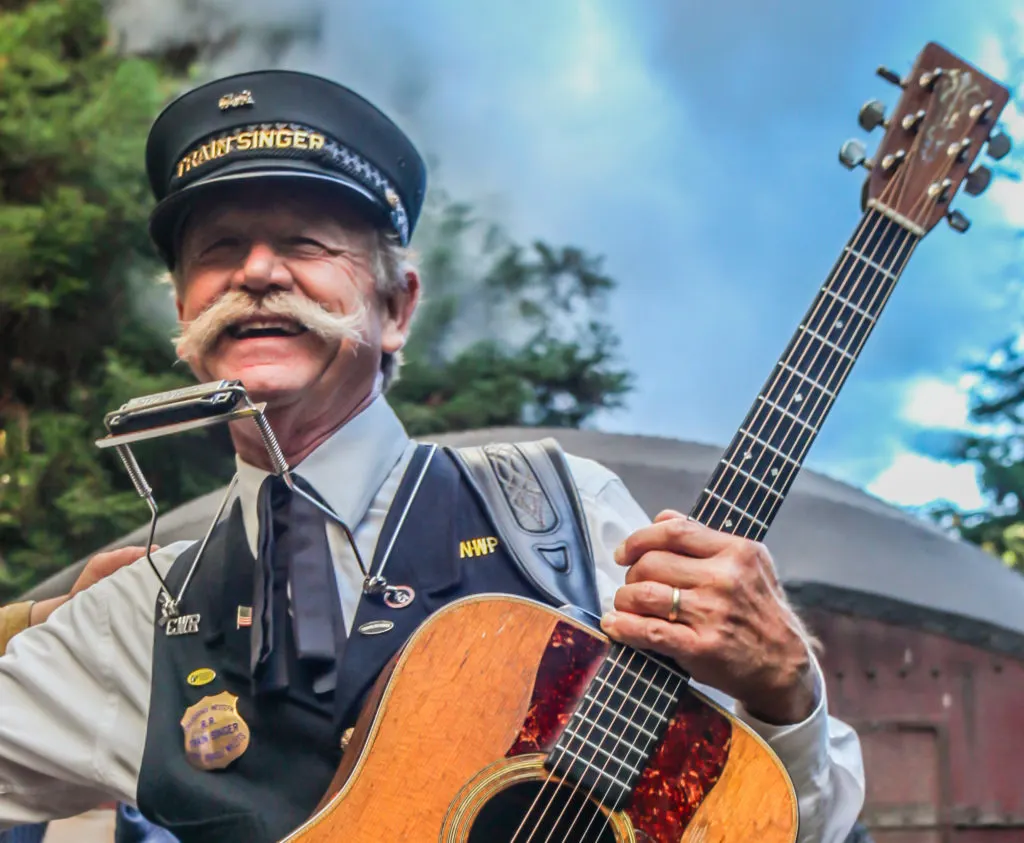If you're looking for a unique and exciting way to experience the beauty of California's Mendocino County, look no further than the Skunk Train. This historic shortline railroad offers a variety of excursions through the redwoods, from scenic trestle bridges and tunnels to pumpkin patches and hiking trails. Whether you're a train enthusiast or simply looking for a fun family outing, the Skunk Train has something for everyone.

The Skunk Train runs from the coastal town of Fort Bragg to the cowboy town of Willits, winding its way through some of the most breathtaking scenery in California. Originally built in 1885 to transport redwood logs from the rugged backcountry to the coast, the Skunk Train now ferries sightseers to and fro, offering a unique perspective on the region's natural beauty. With a range of different options to choose from, including the Pudding Creek Express, the Pumpkin Express, and the Roundhouse Tour, there's no shortage of ways to experience the magic of the Skunk Train.
Skunk Train: A Unique Experience through the Redwoods
History of the Skunk Train
If you're looking for a unique and historic train ride, the Skunk Train is a must-see attraction. The Skunk Train has a rich history that dates back to the early 1900s. Here is a brief overview of the history of the Skunk Train.
Early Beginnings
The Skunk Train was originally built to transport logs from the forests of Mendocino County to the sawmills in Fort Bragg. The railroad was first established in 1885 by the Fort Bragg Railroad, which was later acquired by the Northwestern Pacific Railroad. In 1904, the Union Lumber Company purchased the railroad and began using it to transport logs.
Union Lumber Company
The Union Lumber Company was the primary user of the Skunk Train for many years. The company used the train to transport millions of board feet of lumber from the forests to the sawmills. The Skunk Train was also used to transport employees to and from work, as well as to transport supplies and equipment.
Transition to Tourism
In the 1920s, the Skunk Train began to transition from a logging railroad to a tourist attraction. The railroad introduced motorcars, which were self-propelled railbuses that could carry passengers. The motorcars were nicknamed “Skunks” because of their distinctive smell. The Skunk Train became a popular attraction for tourists, who could ride the train through the scenic forests of Mendocino County.
Today, the Skunk Train is still a popular tourist attraction. The train has been restored and modernized, but it still retains its historic charm. You can ride the Skunk Train and experience the beauty of the redwood forests and the history of the railroad.

The Skunk Train Summit on a sunny day show sunny meadows with forest in the background in Mendocino County, California
The Skunk Train Experience
If you're looking for a unique and unforgettable adventure, look no further than the Skunk Train! This historic railway takes you on a journey through some of the most beautiful scenery in Mendocino County, California.
Route Overview
The Skunk Train runs along the historic Redwood Route, passing through stunning redwood forests, over trestles and through tunnels. You'll cross Pudding Creek on the Pudding Creek Express and make the hairpin turn at Wolf Tree, where you'll see the famous Wolf Tree Turn. As you continue on, you'll pass through Tunnel #2 and enjoy breathtaking views of the Pudding Creek Estuary and Noyo River Canyon.
Train Features
The Skunk Train offers a variety of coaches to choose from, including open-air cars, enclosed coaches, and even a first-class car with plush seating and a private attendant. You'll also have the opportunity to ride on a steam locomotive, which is a real treat for train enthusiasts.
Special Events
The Skunk Train hosts a variety of special events throughout the year, including the Pumpkin Express and the Magical Christmas Train. During the Pumpkin Express, you can ride the train to a pumpkin patch, where you can pick out your own pumpkin and enjoy a variety of fun activities. The Magical Christmas Train takes you on a journey to Mr. Skunk's Magical Workshop, where you can see the World's Largest Living Christmas Tree and enjoy hot cocoa and cookies.
Whether you're a train enthusiast or just looking for a fun and unique adventure, the Skunk Train is sure to delight and amaze you. So why not hop aboard and see for yourself what makes this historic railway so special?

Engine #45 steaming.
Tickets and Planning Your Visit
Planning your visit to the Skunk Train is easy and straightforward. Here is some information that will help you make the most of your trip.
Ticket Information
Tickets for the Skunk Train are available for purchase online or at the Fort Bragg or Willits depots. Prices vary depending on the type of trip you take and the time of year. The Skunk Train offers a variety of trips, including round-trip and one-way journeys, as well as special event and holiday-themed trips.
The Skunk Train also offers railbike tours, which are a unique way to experience the beauty of the Redwood Route. These tours are available for two people per bike, and prices vary depending on the tour you choose.
Best Times to Visit
The Skunk Train operates year-round, but the best time to visit depends on your preferences. If you enjoy cooler temperatures and fewer crowds, consider visiting during the fall or winter months. The fall foliage is particularly beautiful during this time of year.
If you prefer warmer weather and longer days, plan your visit for the spring or summer months. Keep in mind that these months are also the busiest, so be sure to book your tickets in advance to avoid disappointment.
Visitor Facilities
The Skunk Train offers a variety of facilities for visitors, including restrooms, a concession stand, and a gift shop. The concession stand offers a variety of snacks and beverages, while the gift shop sells souvenirs and other items related to the Skunk Train.
If you're planning on spending the night in the area, consider staying at Camp Mendocino, which is located near the Skunk Train depot in Fort Bragg. This camp offers a variety of accommodations, including cabins and tent sites.
Overall, the Skunk Train is a must-see attraction for anyone visiting Fort Bragg, CA or Willits, CA. With its beautiful scenery and unique history, it's no wonder that the Skunk Train has been a favorite among visitors for over a century.

Engine 65 over a bridge.
Related Post:
The Skunk Train and Local Economy
If you're looking for a unique way to explore the stunning natural beauty of Mendocino County, the Skunk Train is a must-see attraction. This historic railway has been chugging through the redwood forests of Northern California for over a century, and it continues to draw visitors from all over the world.
Economic Impact
The Skunk Train is more than just a fun way to spend an afternoon – it's also a major contributor to the local economy. According to a recent demographic survey, the Skunk Train and Railbikes brought $67.7 million to the local economy over a 5-year period. In total, the Skunk Train brought over 370,000 visitors to Mendocino County who spent an average of $723 above and beyond the cost of their train tickets. This spending generated significant revenue for local businesses, including restaurants, hotels, and shops.
Environmental Considerations
While the Skunk Train is a boon to the local economy, it's important to consider the environmental impact of this historic railway. The train runs through some of the most beautiful and ecologically sensitive areas in Northern California, and it's important to ensure that the train's operations are sustainable and environmentally responsible.
Fortunately, the Skunk Train has taken steps to reduce its environmental impact. For example, the train has switched to using biodiesel fuel, which produces fewer emissions than traditional diesel fuel. Additionally, the Skunk Train has implemented a number of conservation measures, such as recycling and water conservation programs.
Overall, the Skunk Train is a unique and fascinating attraction that offers a glimpse into the history and natural beauty of Mendocino County. Whether you're a local or a visitor, a ride on the Skunk Train is an experience you won't soon forget.
Exploring Beyond the Rails
When you visit Skunk Train, you'll find that there's more to do than just riding the rails. Here are some of the ways you can explore the beauty of the area beyond the train tracks.
Railbike Adventures
If you're looking for a unique way to experience the redwoods, then a railbike adventure is a must-try. You can pedal your way through the stunning scenery on a guided tour that takes you along the Pudding Creek Estuary and to the historic Glen Blair Junction. Along the way, keep an eye out for egrets and other wildlife that call this area home.
Hiking and Nature Trails
If you prefer to explore on foot, there are plenty of hiking and nature trails to choose from. The Skunk Train offers access to several hiking trails that wind through the redwoods and offer stunning views of the surrounding landscape. You can also explore the Pudding Creek Estuary on foot, where you'll find a variety of birds and other wildlife.
No matter how you choose to explore the area around Skunk Train, you're sure to be amazed by the beauty of the redwoods and the rich history of the region. So why not plan your visit today and discover all that this stunning area has to offer?

A train singer entertains for a portion of the Skunk Train ride in Mendocino County, CA
In the Media
Skunk Train has been featured in several media outlets, including National Geographic. The train's unique history and scenic route have captured the attention of many journalists and travel writers.
National Geographic Feature
In 2018, National Geographic named Skunk Train as one of the “Top 10 North American Train Trips.” The article highlighted the train's journey through old-growth redwood groves, scenic trestle bridges, and spectacular tunnels. The author also praised the train's knowledgeable staff and the opportunity to learn about the area's history and wildlife.
Social Media Presence
Skunk Train has a strong social media presence with active accounts on Facebook, Twitter, and Instagram. The train's social media pages feature stunning photos of the train and the surrounding scenery. They also share news and updates about the train's schedule and special events.
On their Facebook page, Skunk Train frequently shares photos and stories from their passengers, creating a sense of community and connection among their followers. They also use their social media pages to promote local businesses and events, showcasing the best of what the area has to offer.
Overall, Skunk Train's media presence reflects their commitment to providing a unique and memorable experience for their passengers. Whether you're a train enthusiast or just looking for a fun day trip, Skunk Train is sure to impress.
Frequently Asked Questions
What are the ticket prices for the Skunk Train?
The ticket prices for the Skunk Train vary depending on the type of experience you choose. The standard round-trip ticket for adults costs $54, while children between the ages of 2 and 12 can ride for $29. There are also special packages available for groups, families, and couples. You can visit the Skunk Train FAQ page for more information on ticket prices and packages.
Can you ride the Skunk Train from Willits to Fort Bragg?
Yes, you can ride the Skunk Train from Willits to Fort Bragg. The train departs from both Fort Bragg and Willits, and the journey takes you through the beautiful redwood forests of Mendocino County. The round-trip journey from Willits to Fort Bragg takes around 4 hours, and you can enjoy a variety of scenic views along the way. You can visit the Skunk Train FAQ page for more information on schedules and routes.
What are the experiences with the Skunk Train rail bikes?
The Skunk Train rail bikes are a popular way to experience the beauty of the redwoods in a unique way. The rail bikes are pedal-powered and ride on the same tracks as the Skunk Train. You can choose from a variety of rail bike experiences, including a 7-mile round-trip ride from Fort Bragg or a 14-mile round-trip ride from Glen Blair Junction. The rail bike experiences are suitable for all ages and offer a fun and memorable way to explore the redwoods. You can visit the Skunk Train FAQ page for more information on rail bike experiences.
How did the Skunk Train get its name?
The Skunk Train got its name from the gasoline-powered motorcars that were introduced in 1925. These motorcars had a distinctive smell, which led to them being nicknamed “skunks”. The Skunk Train has been in operation since 1885 and has a rich history in Mendocino County. You can visit the Skunk Train FAQ page for more information on the history of the Skunk Train.
Is there any controversy surrounding the Skunk Train?
There has been some controversy surrounding the Skunk Train in recent years. Some environmental groups have raised concerns about the impact of the train on the redwood forests and the wildlife that lives there. However, the Skunk Train has taken steps to address these concerns, including using eco-friendly locomotives and working with local conservation groups. You can visit the Skunk Train FAQ page for more information on the Skunk Train's environmental impact.
Are there still regular services on the Skunk Train?
Yes, there are still regular services on the Skunk Train. The train operates year-round, with daily departures from Fort Bragg and Willits during the peak season. The Skunk Train also offers special events and experiences throughout the year, including holiday-themed rides and wine-tasting events. You can visit the Skunk Train FAQ page for more information on schedules and events.
